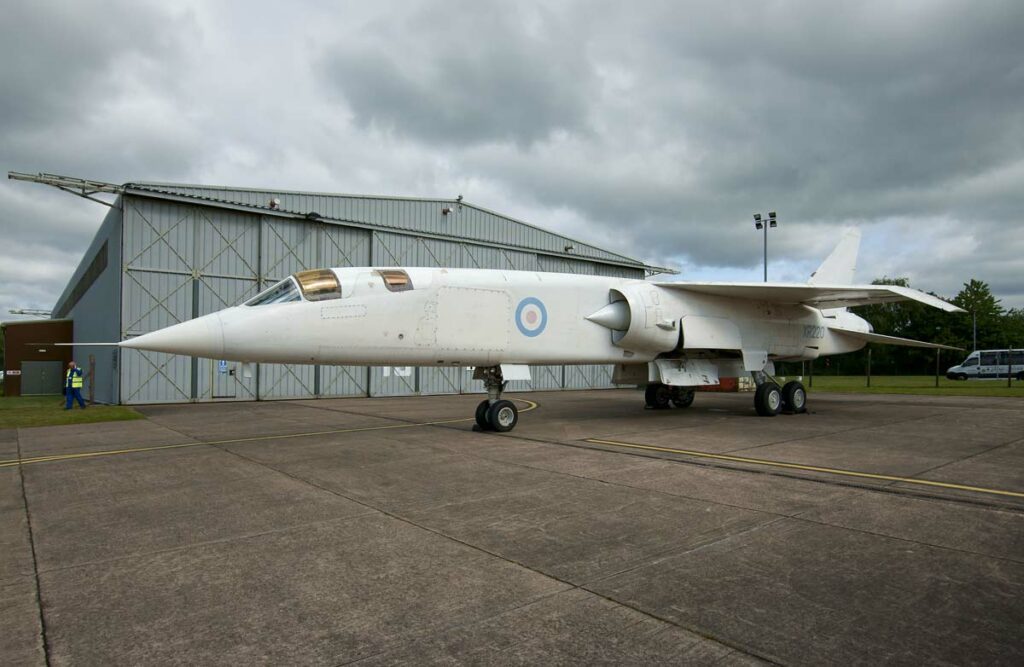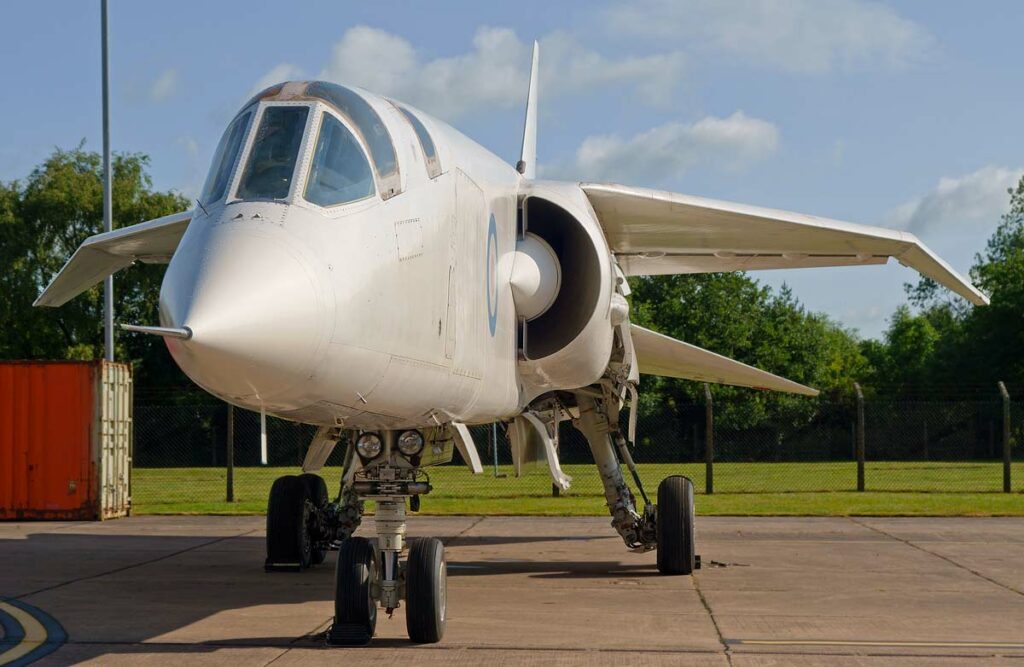The BAC TSR-2 was an advanced British jet-engine strike and reconnaissance aircraft, cancelled before entering service.
In brief
The British Aircraft Corporation (BAC) TSR-2 was a Cold War-era tactical strike and reconnaissance aircraft, designed to meet the demanding requirements of the Royal Air Force (RAF) for a high-speed, high-altitude, long-range aircraft capable of precision strikes. Powered by two Bristol Siddeley Olympus turbojet engines, the TSR-2 was capable of Mach 2.0+ speeds at high altitude, with a proposed low-level speed near Mach 1.1. It featured sophisticated avionics for its time, including terrain-following radar, which allowed it to fly at very low altitudes to avoid radar detection. The TSR-2’s design included a tandem two-seat cockpit, a large payload bay for nuclear or conventional weapons, and was intended to have in-flight refueling capability. Despite its advanced design and successful test flights, the TSR-2 program was controversially cancelled in 1965 due to escalating costs and shifting political priorities, leaving only prototypes and what-if scenarios of its operational potential.

History of the Development of the BAC TSR-2
In the late 1950s, the British government identified a need for a new tactical strike and reconnaissance aircraft to replace aging models and maintain a technological edge in the Cold War environment. This led to the issuance of Operational Requirement 343 by the RAF, which called for a versatile, high-performance aircraft capable of carrying nuclear and conventional weapons over long distances, at high speeds and low altitudes, to evade enemy radar.
The British Aircraft Corporation, formed through the merger of English Electric, Vickers-Armstrongs, and Bristol Aeroplane Company, undertook the development of the TSR-2 in 1959. This project aimed to combine cutting-edge aviation technology with new developments in avionics and weapon systems, positioning the TSR-2 as a key component of Britain’s strategic air capabilities.
The TSR-2 made its maiden flight on 27 September 1964, showcasing its advanced design and potential to fulfill multiple roles within the RAF. Despite its promising performance, the TSR-2 faced numerous challenges, including technical difficulties, cost overruns, and political controversy. Ultimately, the project was cancelled in 1965 by the British government, leaving only a few prototypes and a legacy of what might have been one of the most advanced aircraft of its time.
Design of the BAC TSR-2
The design of the BAC TSR-2 was revolutionary for its era, incorporating many features that were advanced for the early 1960s. The aircraft had an overall length of 89 feet (27.1 meters) and a wingspan of 37 feet (11.3 meters), designed for optimal performance at both high and low altitudes. The TSR-2 utilized a fully monocoque structure made primarily of light alloy, with high-strength steel and titanium used in areas subjected to high thermal and structural loads.
Powered by two Bristol Siddeley Olympus afterburning turbojet engines, the same family of engines later used to power the Concorde, the TSR-2 had exceptional power and speed capabilities. Its avionics suite was ahead of its time, featuring a terrain-following radar system that allowed for low-level flight below enemy radar, an automatic navigation system, and electronic countermeasures to enhance survivability in hostile environments.
However, the ambitious design also brought drawbacks, including complexity, maintenance challenges, and significant development costs. The TSR-2’s advanced technology and performance requirements pushed the limits of the era’s engineering capabilities, contributing to the program’s eventual cancellation.
Performance of the BAC TSR-2
The TSR-2 was designed to excel in high-speed, low-altitude penetration missions, capable of speeds over Mach 2 at high altitude and near Mach 1.1 at low altitude, with a projected service ceiling above 40,000 feet (12,192 meters) and a range of approximately 2,500 nautical miles (4,630 kilometers) with external fuel tanks. Its performance was tested during a limited number of flights, where it demonstrated significant potential to meet or exceed its design specifications.
When compared to contemporaries such as the General Dynamics F-111 Aardvark and the Soviet Sukhoi Su-24 “Fencer,” the TSR-2 was notable for its advanced avionics and low-level flight capabilities. However, its full operational potential and comparative performance remain speculative due to the program’s early termination.
Variants of the BAC TSR-2
The TSR-2 program was cancelled before any operational variants were produced. However, several proposed versions included:
- TSR-2: The standard tactical strike and reconnaissance version.
- TSR-2P: A proposed photographic reconnaissance variant.
- TSR-2B: A proposed version equipped for the strategic bombing role.
Each variant would have built on the base TSR-2 design, adapting it for specific mission requirements.

Military use and combat of the BAC TSR-2
The BAC TSR-2 never entered military service or combat due to its cancellation. Its intended roles would have included deep-penetration strikes, tactical nuclear delivery, and high-speed reconnaissance, significantly contributing to NATO’s Cold War deterrence strategy. The cancellation of the TSR-2 program led to the RAF seeking alternative aircraft, such as the purchase of the F-111 (later cancelled) and the development of the Panavia Tornado, to fulfill its operational needs.
The BAC TSR-2 remains one of the most intriguing “what-if” stories in military aviation history. Its advanced design and performance capabilities positioned it as potentially one of the most effective strike and reconnaissance aircraft of its time. However, the TSR-2’s cancellation left its operational impact untested, making it a symbol of both British engineering ambition and the complex interplay of technology, politics, and economics that can influence military procurement decisions. Despite its absence from the skies, the TSR-2 continues to fascinate aviation enthusiasts and historians as a testament to the innovative spirit of the era.
Back to the Spy Planes section.